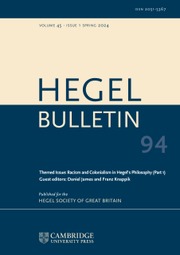Article contents
Spirit's Embeddedness in Nature: Hegel's Decentring of Self-Legislation
Published online by Cambridge University Press: 27 January 2021
Abstract
A recently widely accepted view has it that the nature-spirit distinction in Hegel is to be understood as a distinction between a space or realm that is not normative, or does not involve norms, and one that is or does. Notwithstanding the merits of this view, it has tended to create a separation between nature and spirit which is both philosophically troubling and difficult to reconcile with the picture of Hegel as the arch enemy of abstract or unreconciled dualisms. In this paper I aim to show that the defining phenomenon for this view—collective self-government by norms—is on Hegel's account both dependent on living nature that involves normativity broadly conceived all the way down and also subject to the ultimate normative or evaluative principle of Hegel's Philosophy of Spirit—concrete freedom—the essence of spirit according to him. This is to say that for Hegel the normativity of collectively administered norms is neither the most basic nor the highest form of normativity.
Information
- Type
- Research Article
- Information
- Copyright
- Copyright © The Hegel Society of Great Britain 2021
References
- 5
- Cited by


